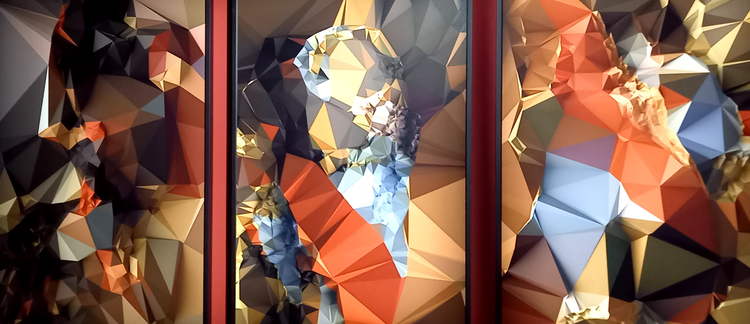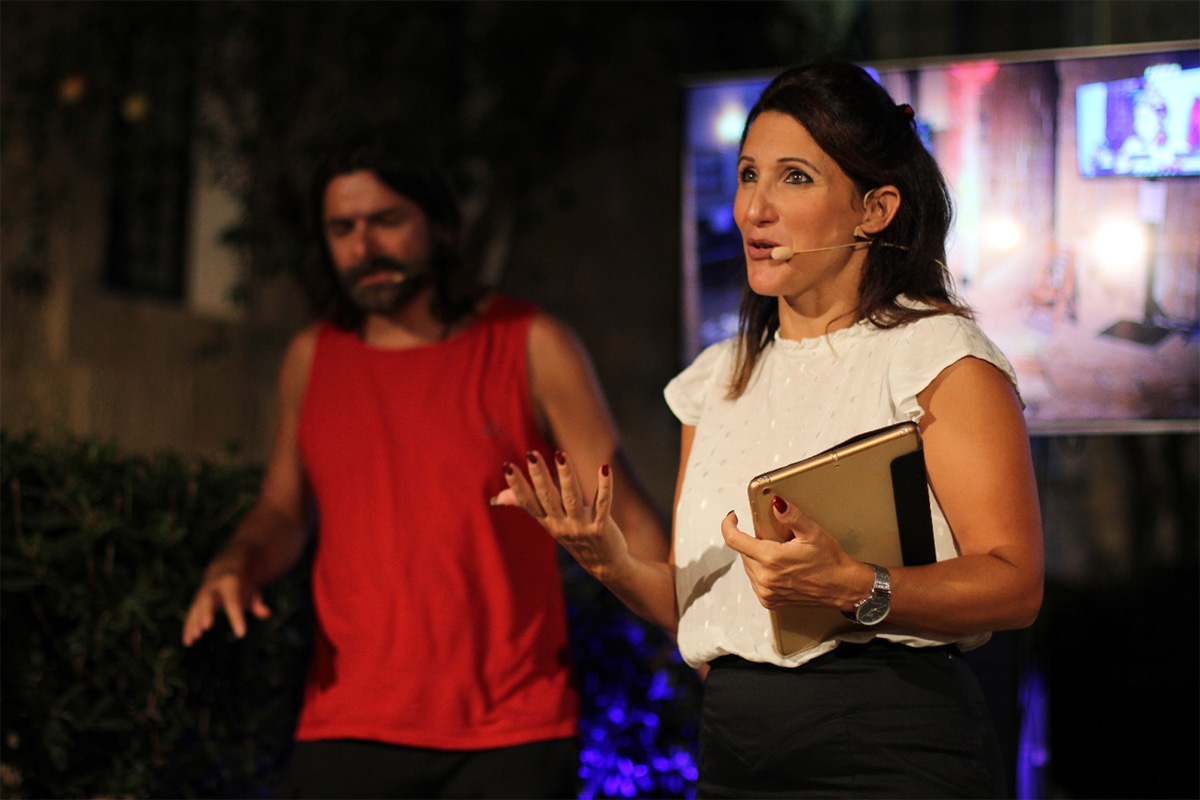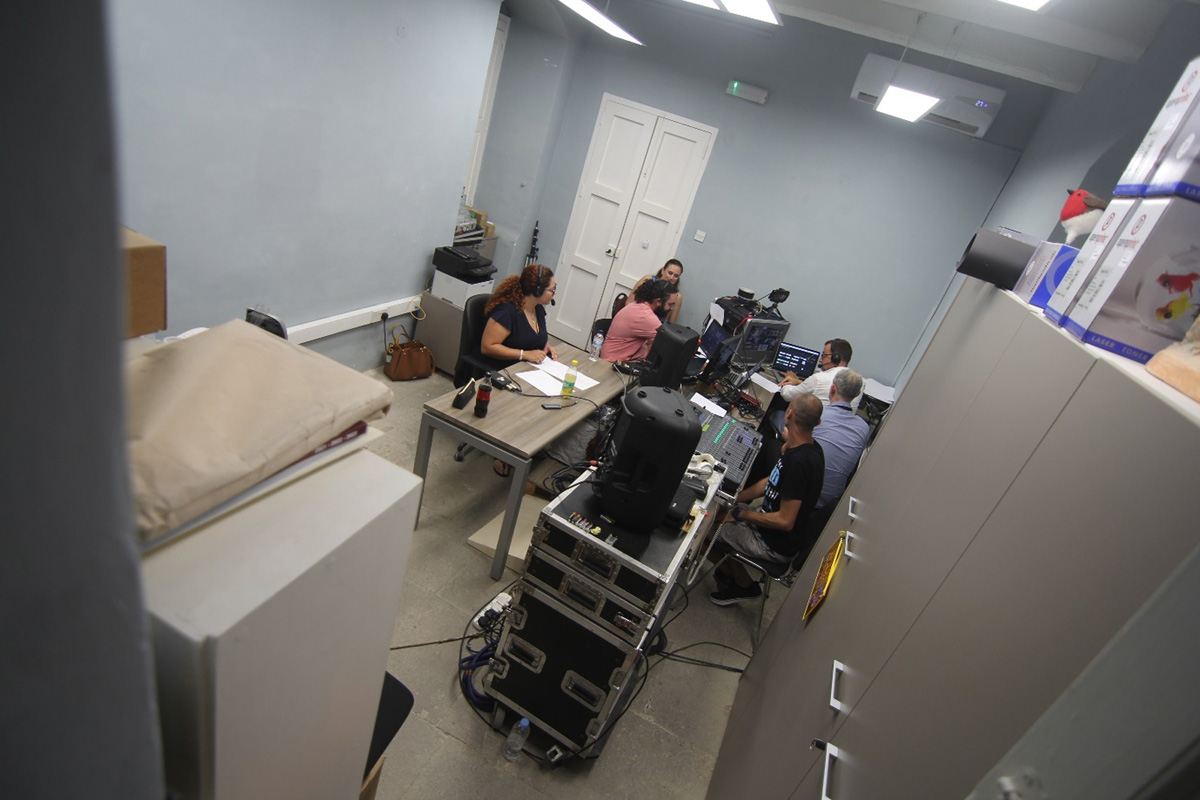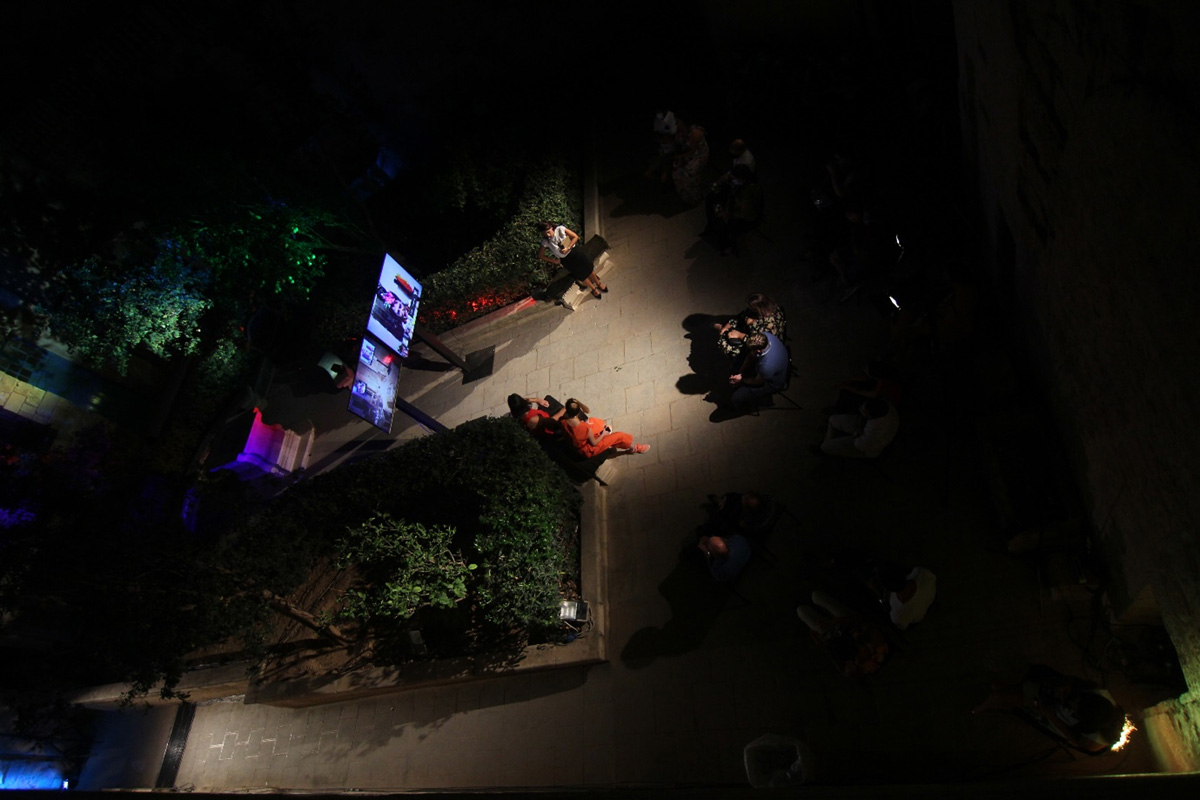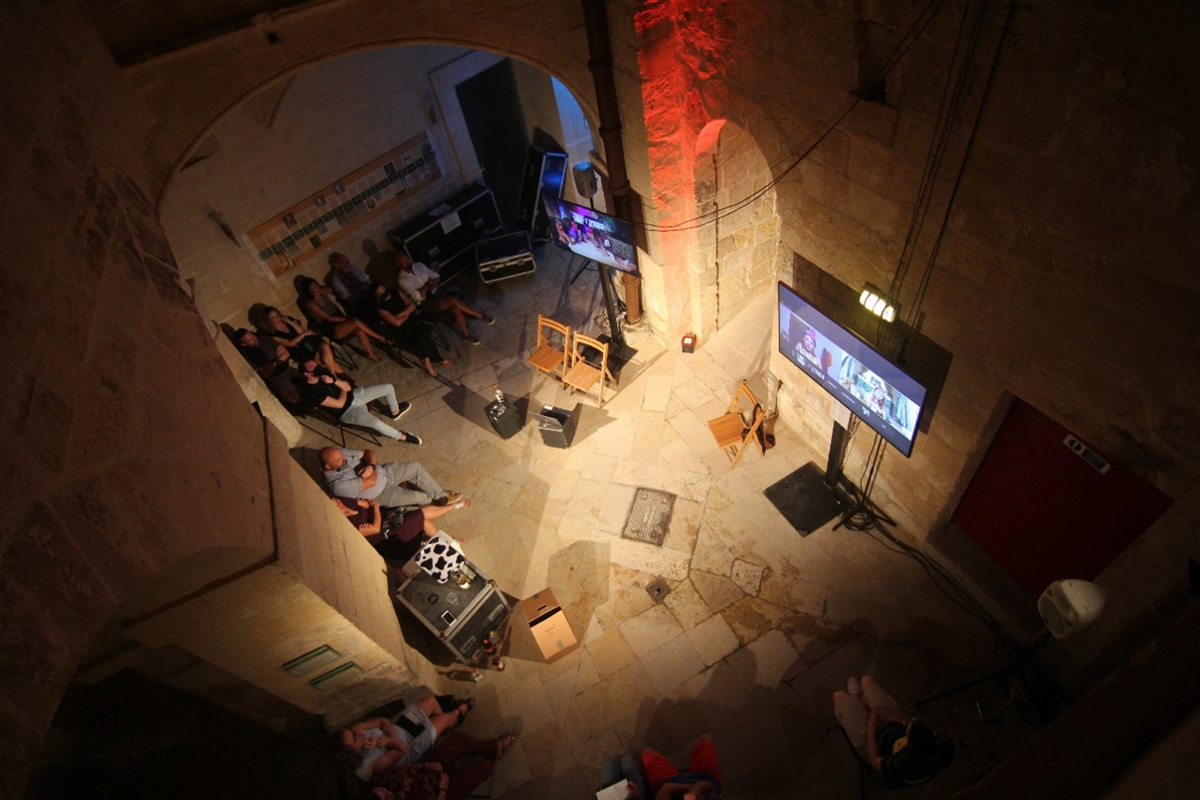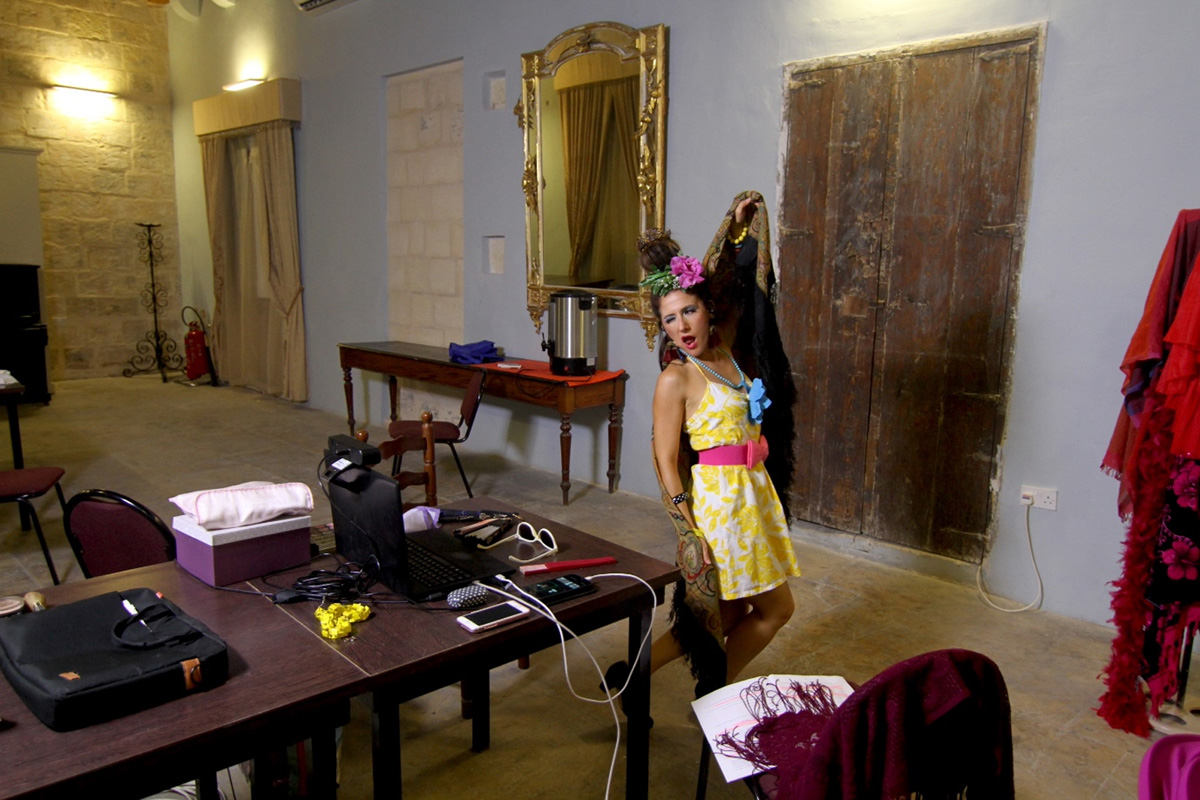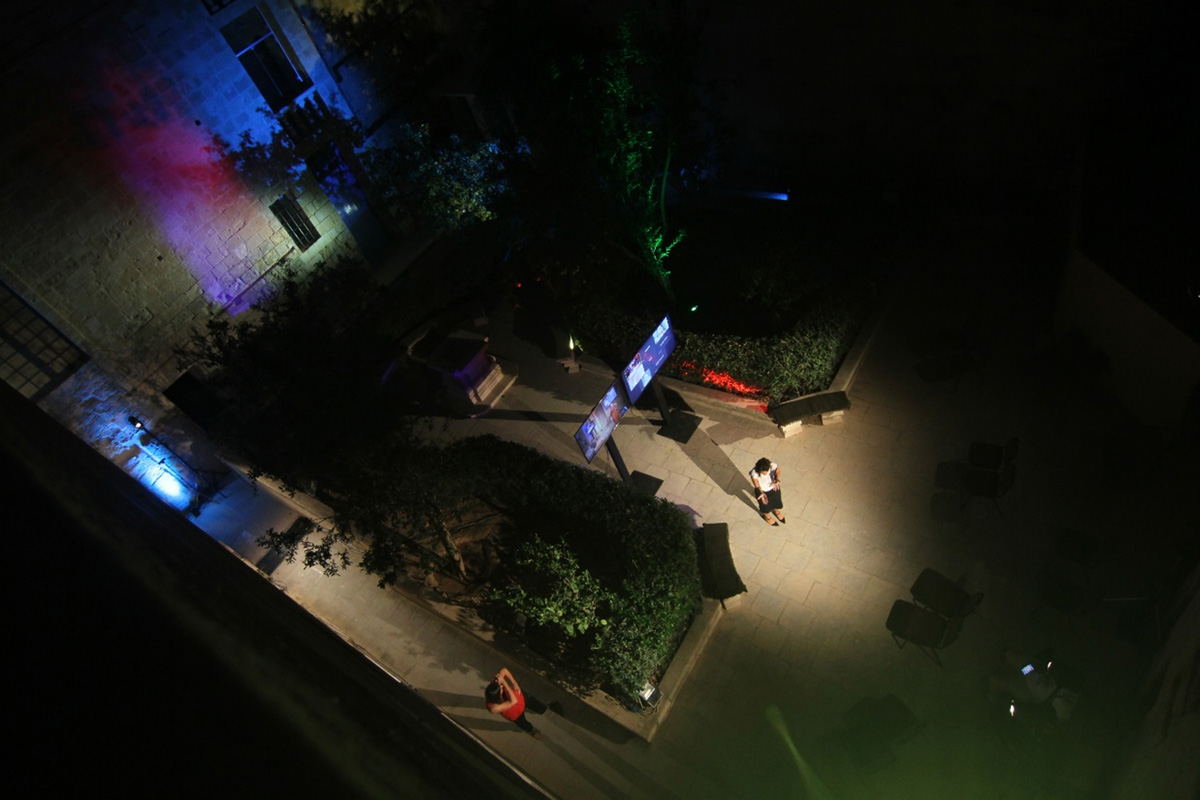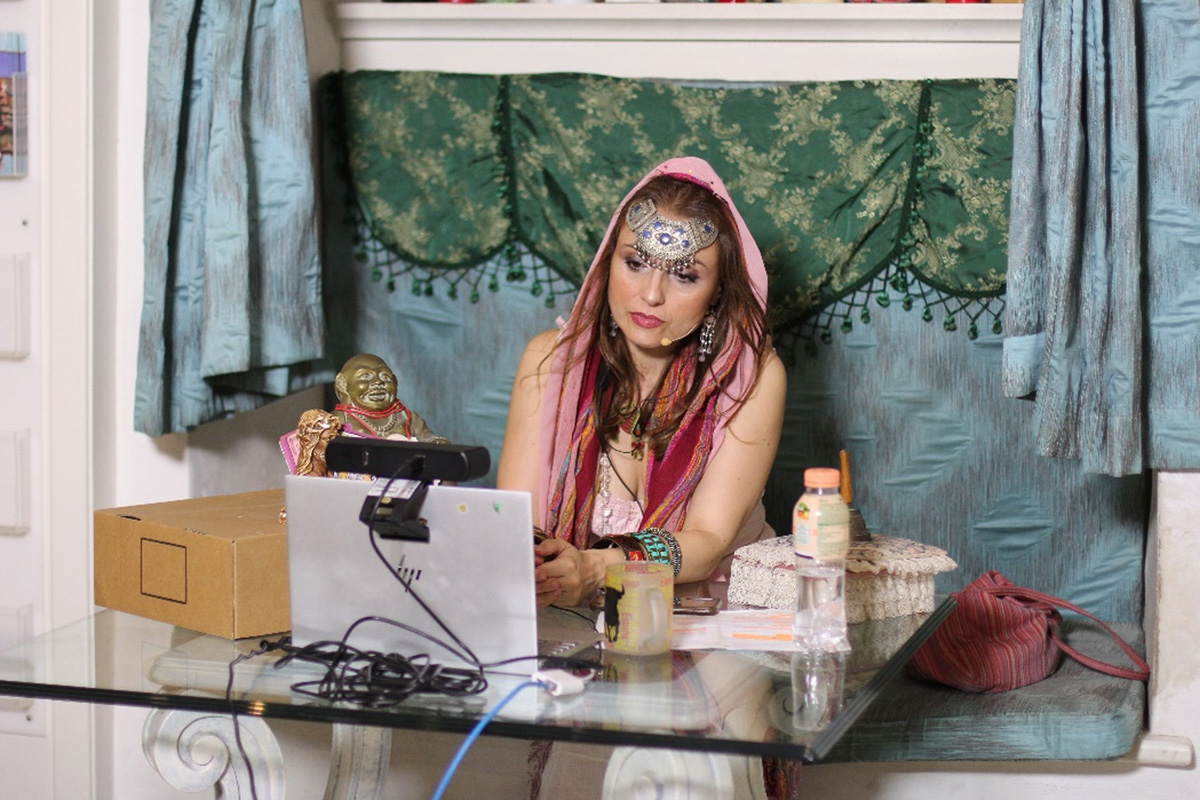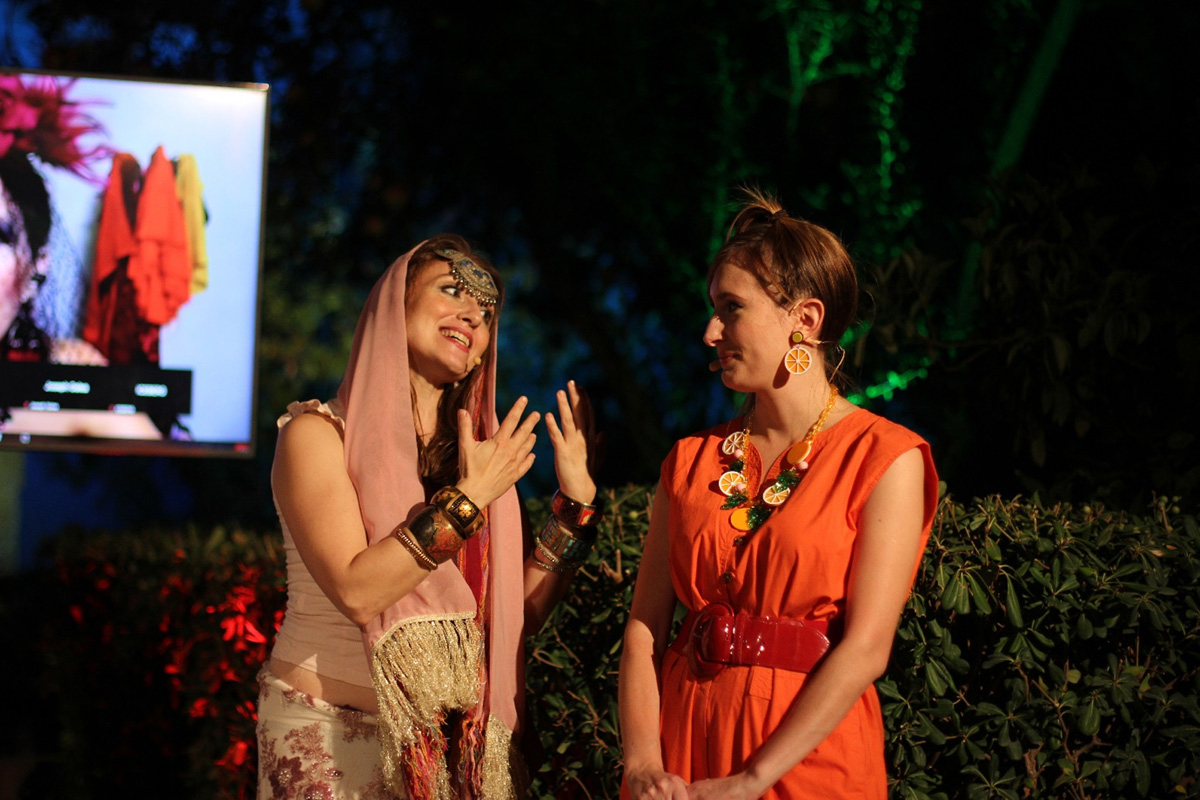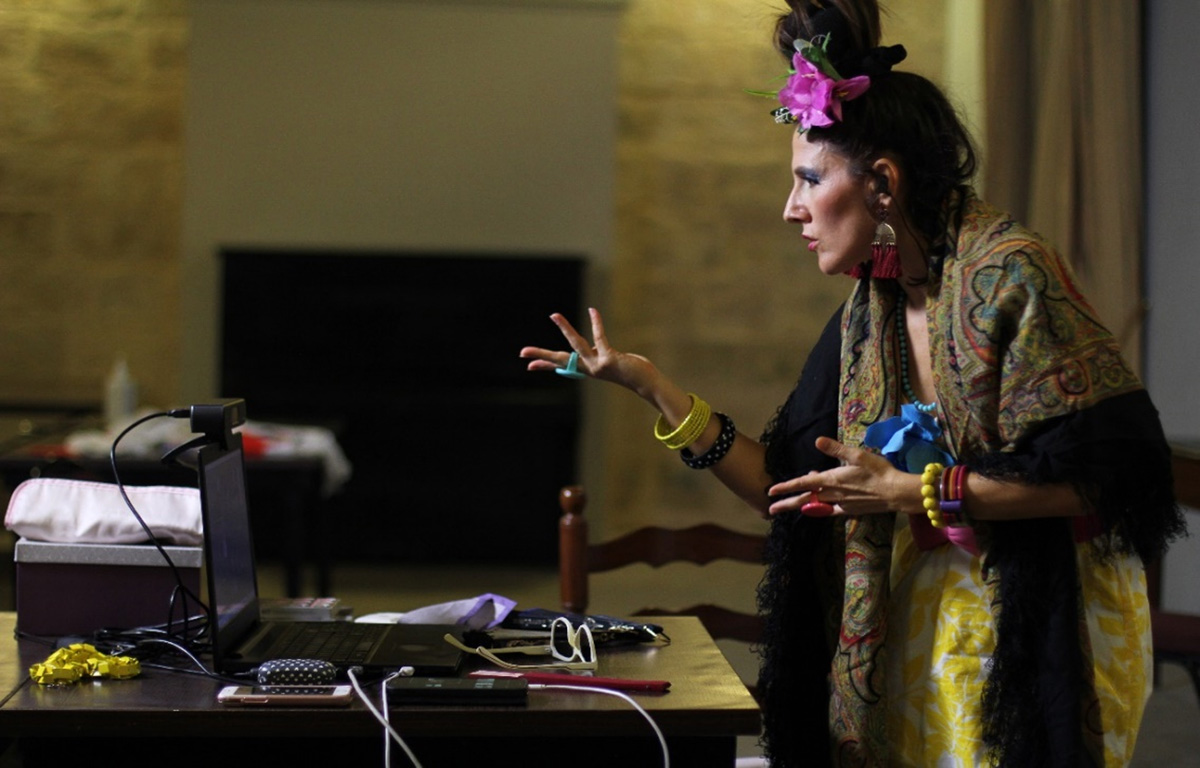Introduction
The term ‘hybrid’ has become an integral part of our daily parlance. Ranging from hybrid vehicles to the notion of the hybrid classroom, this adjective has become synonymous with the culture that defines contemporary society. Particularly at the onset of the Covid-19 global pandemic, the word has also infiltrated into in the world of the performing arts. This paper will analyse the dynamics and the challenges faced by the hybrid theatre production Zoom. This production, staged at the Inquisitor’s Palace in Vittoriosa for a short run between the 17th and the 19th September 2021, was an original and innovative experiment in the Maltese sector of the performing arts, and hence was funded by the Digital Research and Development Fund of the Arts Council. Although locally various practitioners have made use of interactive media in their work, this is the first production that has incorporated the networking platform Zoom as an integral part of the performance. The insights presented will be based on an extensive number of interviews conducted with a variety of members in the creative and the technical team, as well as members of the audience, framed by my experience as researcher who also co-produced, wrote and directed the piece. The objective of this paper is to evaluate the experience of the audience and the performers to discern how effective and engaging a hybrid performance is.
The context
The project Zoom owes its genesis to the first lockdown imposed in Malta in 2020. As a reaction to the closing down of theatres, and the implication that this had on the income and welfare of the artistic sector, I co-produced, wrote and directed a short original piece in Maltese called Mill-Kċina ta’ Connor (In Connor’s Kitchen), performed and watched live on Zoom. One of the spectators was a theatre practitioner, Joseph Galea, who I had collaborated with in the past. On watching the performance, he contacted me and expressed an interest to collaborate on a similar project and co-produce a hybrid performance, based on a short story he had written.
The rationale of the project was to create a hybrid performance where multiple spaces could be used. The audience could choose to watch it online or live, and if live, to choose one of two different spaces where to watch the performance from. Carlos Farrugia (2021), a popular local actor, who played the main role in this production, believes that this set-up provided the spectators the possibility of multiple experiences. A few audience members decided to watch the performance more than once in a different space, or through a different modality, to compare and contrast the difference. The postmodern notion of multiple experiences and realities underlies our modus operandi. Aware of varieties and different possibilities, we crave to experience all angles and perspectives. We also deconstruct and seek to comprehend what lies beneath and behind the scenes in order to discover and appreciate the mechanics. As Stavrides (2006: 30) emphasises ‘space as multiply articulated, transforming, can include different levels of temporal associations’. This project addresses this current craving and incarnates it in the theatrical experience.
The narrative of the short story was developed further and adapted to a play. Samantha, an events manager, organises a show to regenerate her career after the lockdown. She commissions a cabaret artiste, Guapa, who can only perform on screen due to her vulnerable condition. Samantha also invites an audience to react to the show so that this can be uploaded online. Samantha also recruits a friend, Damian, a highly impulsive person, who tends to ignore social mores, and his stupefied sister Gertrude, to prepare the catering. As the show unfolds, despite the meticulous planning of Samantha, technological issues arise. Furthermore, Damian, totally disinterested in the show, develops a crush over Caroline, one of the persons watching the cabaret online. Initially he tries to speak to her through his device, thus interrupting Guapa’s show. Samantha, furious at Damian’s behaviour, goes backstage and an altercation ensues in which the audience discovers that the two were in a relationship twenty years before. During this argument, the internet connection is lost, and the show stops abruptly. Damian saves the situation by serving the food to the audience until the connectivity issue is resolved. Guapa has a panic attack and is calmed down by the sudden intervention on screen by Caroline who shares her admiration for Guapa in the most cryptic language. Guapa suddenly recognises Caroline – she is the daughter of a family who had died in a tragic incident when their roof fell on them. Caroline is upset by this disclosure and hangs up.
Samantha, totally embarrassed by what is happening, announces that the show must be cancelled. However, Damian is adamant on re-establishing contact with Caroline. An interval is proposed where the action moves backstage. Samantha tells Damian the truth: Caroline is her sister-in-law, who had fallen into a depression after the death of her parents. Her sudden obsession with pantheistic religions helped Caroline to overcome her situation. Reluctantly Samantha realises that just as much as her show failed, despite her attempt to control everything, life also cannot be manipulated. She agrees to help Damian find Caroline. However, it is Caroline who turns up unexpectedly. It transpires that Gertrude had contacted Caroline on Messenger and explained that beneath the anti-social appearance of her brother, lies a man who is deeply misunderstood. Damian had cut off any social ties because his mother suffered from dementia. The need to take care of her, and the shame of the mental health issue, spurred Damian to work from home by running a small catering company. Caroline believes that this encounter with Damian is a sign from the gods and she readily accepts to go out on a date with him.
The play was an hour long. The five performers were supported by a technical crew of three technicians, who were responsible for the lights; sound; setting up of screens and cameras; and the live mixing for the online performance. The crew was monitored by the technical director and the assistant stage manager. The props manager took care of the cooking of the food that was served to the audience, besides the procurement and the setting up of props. Due to Covid restrictions, the maximum capacity per night was of forty-five people in both spaces combined. The three performances were sold out. We also had a further twenty people per night watching the performance online.
The merging of what was, is and will be
An important dimension that underpinned this work was the bridging between the past and the future, between the traditional and the avant-garde. An evident dynamic that emerged and developed in the lockdown in the theatre sector was a nostalgic approach and a desire to turn the clock back. This reactionary attitude, as well as the uncertainty that Covid brought with it, prevented experimentation in the sector. With the exception of small theatrical groups and independent practitioners, that explored the interface between technology and performance in creative, and at times, risky ways, the larger companies, and in particular the state-run entities, preferred to hibernate, hoping for better days. Kim Dalli (2021) remarked ‘theatre should mirror our lives and technology is part of our lives.’ Locally this mirroring did not happen in as widespread a manner as would have been expected. This project investigated this interface with technology without denying or obliterating the more traditional way of theatre-making. In this production, the romantic comedy genre, heavily influenced by the Maltese farsa, as well as other Mediterranean comedic influences, was an homage to the old days when community was created in the traditional village theatres. Yet the introduction of screens and technology as an important feature not only in the devising, but moreover in the plotline itself, rooted the performance in a contemporary setting, hampered, or at least modified by the Covid reality. Although the social fabric has been embedded in the technological environment for the last decades (Leeker, Schipper & Beyes 2017:10) Covid consolidated and intensified this culture. This bridging between the past and the future was also expressed in the hybrid dimension of this play. The live performance was indicative of the desire to the return to the pre-Covid phase, albeit with seating limitations, whereas the online performance showed that this mode of viewing cannot be discarded, even in a post-covid society. Hence, this tension between the past, the present and the future is outlined by the pandemic which separates time into the pre-Covid and the post-Covid (yet to come, hopefully) phase. In this performance, Covid was not only a contextual element that fostered the creation of the performance but was integrated as a ‘character’ in the plotline: Samantha organises the event to make up for the financial loss suffered in the lockdown and the play has constant references to Covid.
This project was also a social commentary on the current political scenario. It referred to a number of pertinent key issues faced by the sector. By the time the performance was staged, the Covid situation in Malta had improved significantly, and most restrictions were uplifted. These decisions did not only happen on the basis of the rising number of vaccinated persons and, by consequence, the declining number of active cases and deaths, but, furthermore, in the light of an upcoming general election that required the current government in administration to take decisions that would please the public. This is reflected in the promotion of specific industries, as opposed to other sectors, such as the performing arts, which were allowed to operate only in a limited manner, and not given a level playing field. The market of the performing arts in Malta is still a niche market. Even though the statistics in 2016 show that 32% of the population goes to the theatre once a year (Leone Ganado 2017), this percentage incorporates the large number of people who watch the traditional Christmas pantomime once a year. Cremona (2019) clearly shows that on average performances are only staged twice in Malta. The capacity of the leading theatre houses in pre-Covid Malta ranged from 100 to 1000 seats. Whereas other sectors such as the hospitality or the retail sector were facilitated since they generate significant revenue in the local economy, theatre producers had to ensure more restrictions such as a 1.5 metre difference between clusters; the obligation to present a certificate of full vaccination on entrance; and the wearing of masks throughout the whole performance. In the light of these dynamics, the play contained comments on the political dynamics in the country. Apart from the general disrespect to the acting profession and the constraints that performers face, the play referred to the booming construction industry that the government is promoting, without acknowledging sufficiently the impact this has on the cultural and natural habitat (Vassallo 2021).
Evaluation
This section will evaluate the principal goals of this project, in the light of the major challenges that arose in the process, and the insights gained. The main areas that will be explored are the spatial dynamics; the use of technology; performative styles; and audience engagement. This analysis will also take into account two other online performances held in Malta to discern the significance that this performance had in the local artistic ecology. These two performances are Mill-Kċina ta’ Connor (May 2020) and Apocalysmas: A Christmas Romp, a children’s pantomime held in December 2020.
The spatial dynamics
The project experimented with the notion of multiple spaces to test out whether it was possible for a performance to take place in different spaces simultaneously. A site was chosen with two outdoor spaces that were connected to each other through a narrow corridor. One space, referred to as the garden, was the space of the ‘show within the show’, that is the event organised by Samantha. In this space the audience was acknowledged, and the characters interacted with them accordingly. The second space, referred to as the courtyard, was the backstage space, where the catering manager was preparing the food. In this space the characters vented out all their frustration and angst, caused by the technological mishaps, as well as by their personal life issues. In the courtyard, the audience was not a character but served as a fourth wall.
This public/private dichotomy was also mirrored in the principal objective of the protagonist. His ‘prying’ of the thumbnails was juxtaposed against the eavesdropping of the audience invading the privacy of the spatial territory of the characters, and in the process, discovering more about their intimate and significant relationships. This also mimics the social interactions that happen regularly in online activities across the globe whereby video-conferencing platforms allow participants to snoop into the personal spaces of others. The notion of the thumbnail makes us all peeping toms who can gratify ourselves in these activities and discover more the personal space of other people, including persons who are totally unknown. Zoom, as a platform, condemns us to be voyeurs and this theatrical project replicated the pleasure and enjoyment attained by the intrusion into the privacy of what lies beyond the closed doors of other people.
The actors also performed in a multitude of spaces. The cabaret artiste was online throughout the whole performance. Her acting space was an indoor hall at the top of the same building where the performance was held. The love interest of the catering manager appeared as a thumbnail throughout the first half of the performance. In the middle of the performance, she intervenes and shares the screen with the cabaret artiste and in the dénouement, she makes a surprise physical appearance in the garden. From a logistical perspective, this required the performer to be in a room as close as possible to the live acting space. The other characters used both the garden and the courtyard but were never part of the Zoom call. One of the performers remarked that this binary dimension created a fascinating performative opportunity whereby within the same performance the actor could interact with the audience and also maintain the fourth wall (Dalli 2021). The spatial axis between the virtual and the physical, experienced within the same performance by both spectators and performers, could define this experiment as a multi-hybrid performance, where the interface between technology and the performative can be examined from different perspectives. The terms used by Broadhurst (2021) can also be applied to this project: Zoom can be considered a somatic hybridised performance, in which the physical is extended into the virtual, and the virtual into the physical, as well as an example of intrinsic hybridity, whereby ‘there is a dynamic convergence of media that never quite becomes an indistinguishable fusion’ (5).
The two spaces were interconnected through an intricate use of screens and camera work. Each space had a big screen, where the cabaret show could be seen. Both spaces had a smaller screen which allowed the audience to watch what was happening in the opposite space, in such a way that what was live in the courtyard was seen digitally by the audience in the garden, and vice-versa. By interconnecting the spaces, this project attempted to transcend, and potentially defy, the inherent trait of networking platforms that do ‘not readily lend itself to social connection or reciprocal or mutual gaze’ (Neideck, Pike, Kelly & Henry 2021: 51). Yet this became a ludic illusion, for although all participants, be they performers or spectators, were aware that they were being gazed at, frequently the suspension of disbelief was exploited. An example of this was the use of the second screen in both spaces which was ‘ignored’ by the characters, placing the audience in a situation where they were more aware of the dynamics and comments in the opposite space than the characters were. Online spectators, on the other hand, could also choose not to reciprocate the gaze by switching off their cameras.
The spatial dynamics of the design of this production, however, also created challenges for the performers. Axisa (2021) described the hurdle of isolation that was particular to her situation. The absence of the physical other impacted on her performance. Her theatrical projection of the character in the rehearsal room, where the rest of the cast was physically present, had to be altered and become more contained when she was performing in front of the Zoom camera.
The other performers were challenged by the timing of the movement to transit from one acting space to the other (Casha 2021; Dalli 2021). Even though the installation of two cameras, in opposite directions, to capture the transition on screen, facilitated the timing, the performers needed to ensure that the transitions were not lengthy. Frequently they had to improvise lines to connect the scene from the garden and the courtyard, and vice-versa.
These difficulties were addressed in the rehearsal room, where the same dimensions of the performing space were replicated. The dynamics were, nevertheless, different. The passageway in the performance space was on a gradient, making walking fast, particularly if carrying props, cumbersome. Furthermore, even though Antonella Axisa and Angele Galea, who played Guapa and Caroline respectively, performed in a separate part of the rehearsal room, they still had contact with the other performers. On one hand, this was beneficial. In the performances, Axisa (2021) used this memory of the rehearsal process, as well as the extravagance of the character, and the interpretation of the actors on the digital platform, to energise her. However, neither of them was fully prepared for the isolation that they experienced in the performance. An interim stage, possibly during the last run-throughs before going on site, could have been scheduled so that the two actresses could have an experience of performing in isolation. This could have easily been done by asking them to rehearse in a separate room, connected with the main rehearsal room through a Zoom call.
Technology
The project set out to test how technology could be integrated with the performative expression in a hybrid reality. Yet the technological dimension presented the most evident challenges and difficulties. Angele Galea (2021) expressed her fear of having to perform over a zoom conference because it placed her in a state of constant vulnerability. Her source of anxiety stemmed from her incapability to fix any technical difficulties such as the loss of connectivity or sound. The same sense of anxiety was experienced by Antonella Axisa (2021), who was initially overwhelmed by the steps required prior to every performance to ensure that all was functioning efficiently. This anxiety was also shared by the co-producer Joseph Galea (2021) who felt disarmed when technological issues arose in production week. The anxiety is also intimately linked with another methodological hurdle performers experience in Zoom-based productions: how ‘to discover unnatural ways of being natural’ (Neideck, Pike, Kelly & Henry 2021: 54). The performer may struggle to integrate the Zoom reality with the unnaturalness of the theatrical expression. Moreover, the performer was competing with the overpowering physical presence of screens and images. This overstimulation could easily upstage what was taking place in the acting space. These difficulties were pertinent and unique to this production within the local reality. In the two online productions referred to, these challenges were avoided. Mill-Kċina ta’ Connor was a one-person performance that did not require a complex technological infrastructure whereas Apocalysmas was pre-recorded.
To address these pertinent concerns and to be able to guide the actors better, I asked the technical director to be present for a number of rehearsals to ensure that all decisions taken were feasible, thus also providing a (limited) degree of peace of mind for the actors as they threaded in unchartered territory and minimising the difficulties that could arise in production week. Furthermore, the challenges in using Zoom, including all the difficulties that arise in such calls, were purposefully integrated into the production, rather than concealing them. Guapa and Caroline were not played by actors pretending to be online. They really were in a zoom call. The script made also constant references to Zoom language such as ‘unmuting’, often serving as punch lines. The play also used these sources of anxiety which regularly feature in our use of these platforms as a major source of humour, underlining the thin line between fear and comedy. This features extensively in network conferencing where these challenges may be a source of anxiety to the organisers and simultaneously a trigger to smile for the passive participants, ‘entertained’ by the random mishaps that occur online. This also justified technical shortcomings that the platform is infamous for, such as lagging. Rather than hiding these shortcomings, they were accepted as part of the dynamics of communication on Zoom. In this way, any minor technological problem could be turned to the advantage of the actor who could incorporate it in the plotline. In one of the performances, the agitated voice of Guapa was slightly muffled. Samantha asked her to calm down because she could not hear her properly. This intelligent addressing of the problem by highlighting, rather than concealing it, worked effectively, even though the actress did not know whether, and to what extent, the auditory issue would be resolved.
Important directorial decisions were also taken to ensure that the movement and the reactions of the actors were restrained so that the audience is not overwhelmed by the richness of the multiple semiotics in the space or the complexities of the process. For example, Ms Galea (2021) related how she had to ‘translate’ this approach in three modes. As she performed in the thumbnail, and eventually on a split screen, Ms Galea felt that she needed to present an abstraction, whereas it was only in her live appearance at the end of the play that she could depict the character in a deeper way. The economy of movement, due to the limited physical space, was exploited to facilitate the attention of the audience. Like in the early renaissance tableaux where the positioning of the secondary characters in the painting served as an indicator for the viewer to focus on the main figure, the configuration of the actors in the space highlighted the presence of the cabaret artiste on the screen, emphasising the main locus of attention. This configuration was likewise physically broken when the attention was shifted to the interaction of the characters in the acting space.
A posteriori, Chetcuti (2021) the technical director, maintained that these technological issues could have been contained more effectively had the play been blocked earlier or had there been a system of cameras installed in the rehearsal room so that he could follow the whole process. Nonetheless, Chetcuti confidently believed that the technical hurdles inherent in this ‘out of the box’ project were addressed successfully.
Performative modes
The varied modes in this performance, which were one of the main objectives of the experiment, challenged the performers and spurred them to equip themselves with skills to respond to the needs that the technological infrastructure required. In digital performances ‘human beings and technological apparatuses enter instead into a relation of performativity’ (Leeker, Schipper & Beyes 2017:11) but for this relationship to be effective, the actor needs to know his medium well. Being aware that their movements were captured on a camera presented challenges because the actors had to work theatrically and for a camera simultaneously. They needed to be sensitive to sightlines, just as much as to the framing of the camera. Furthermore, they only had a limited amount of days to adapt to this balance between the two opposing media (Joseph Galea 2021). The play was reblocked on site over a weekend, and the rest of the days leading to the premier focused on the technological hurdles that developed. Kristjana Casha (2021), who played the role of Samantha, also pointed out that the hybrid nature of the project imposed constraints on the actor who had to constantly make decisions on how to project her character vocally, emotionally and psychologically in an adequate way for the digital, as well as for the physical version. This constant tension could also result in weaker characterisation since the performer might concentrate more on the technique than the interpretation. Casha also mentioned that a rhythm that worked well in the physical performance felt too slow when watched online, placing the performer in an ambiguous situation of having to decide which modality to give priority to, and running the risk of not doing justice to either.
Yet the nature of hybridity questions conformity and transgresses boundaries (Broadhurst 2021: 5) and places the encounter between the actor and the spectator in unfamiliar grounds, offering the possibility of rediscovering this relationship in a new, fresh, and potentially more effective way. In fact, Dalli (2021) had the opposite reaction to Casha. The close proximity and the microphones led to a more natural form of interpretation that according to her was amenable to both live as well as online viewers. As a director I encouraged the actors to deliver a more naturalistic interpretation which might suit the camera more, without discarding the theatrical flamboyance that I felt the piece needed. This decision was also taken in the light of the fact that the audience was seated very close to the performers. However, this issue was not satisfactorily addressed. Elaine Falzon (2021), an audience member, experienced negatively the overstimulation in specific moments of the play, where loud auditory and emotional outbursts did not benefit the experience. Lara Zammit (2021), the reviewer of the Times of Malta, remarked that:
The only fracture I perceived was in the cacophonous nature of a great number of scenes. Comedies are not always known for their subtlety…such comedies can be quite polarising, some finding them hilarious and others intolerable.
In hindsight, I believe that the performers needed to be coached in a tighter way and to be more ‘subtle’. By opting for a mid-point approach, which is neither here nor there, the performance ended up being at times too bland for some audience members and too lurid for others. Previous local online productions could not be referred to in order to address this challenge. All viewers of Mill-Kċina ta’ Connor and Apocalysmas were online.
Audience engagement
One of the goals of a hybrid performance is to extend audience engagement and address the issue of accessibility. This section will focus on this goal whilst examining the difficulties that members of the audience, particularly online viewers, had in their interaction with the performance and how this impacted on the process of the actors.
There was a myriad of reasons given by spectators as to why they opted to watch Zoom online. Some people were not permitted to attend because they were not fully vaccinated. The current health protocol disallows non-vaccinated persons from going to public events (Ministry for Health 2021). This exclusion from participation in the cultural world was surpassed through the digital option. A second factor that led viewers to opt to watch the play from the commodity of their homes was the fear of going to the theatre, possibly reinforced by government policies that sadly indicated that going to the theatre, despite the controlled environment, is more hazardous than going to a restaurant or to a wedding celebration. Other persons did not watch because of personal issues such as transportation problems or difficulties to arrange for childminding services. An unexpected reason given for the choice of watching the performance online was a busy lifestyle that did not allow the concerned persons to make time to prepare themselves for the event – what Schechner 2013: 225 refers to as the proto-performance. Furthermore, the social element of the theatrical event, at least when it happens live, may be a deterrent to those who do not have anyone to watch the performance with. The online option offers them the possibility of watching a play on their own without triggering off any form of uncomfortableness or emphasising their social isolation (Borg 2021). This also resulted in less over crowdedness since the spectators did not necessarily need to attend physically to watch. Falzon (2021) commended the experience as being very safe and well-managed. Finally, the performance was an opportunity for the Maltese living abroad to watch the latest developments in the local scene, creating a possibility ‘to level the geographic playing field’ (Neideck, Pike, Kelly & Henry 2021: 55).
Kristjana Casha (2021) observed that the online possibility increased audience engagement because it encouraged people who did not attend the theatre due to financial constraints, to watch the performance at a less expensive rate. Online tickets were eight euros cheaper, and it was sold per device, resulting in the possibility of more than one person watching the performance. Farrugia (2021) also mentioned that several people approach him, particularly the elderly, saying that despite their desire to watch him perform live, are disheartened by the fact that plays are generally performed in the evening in Malta. Farrugia also commented that the social media has made society lazy to the extent that, given a choice, people will stay at home rather than go out for their entertainment. This is a phenomenon that has increased exponentially in Malta in many industries. Netflix, and other similar structures, have led to a drop in attendance at the cinema, with a remarkable difference of over 580,000 between 2019 and 2020, mostly due to the lockdown and the subsequent restrictions (NSO 2020; 2021). The increase in food delivery services has also resulted in less people dining at restaurants (Statista 2021). Joseph Galea (2021) is concerned that the online option could have negative repercussions. Although it could extend audience engagement, the ‘laziness’ referred to by Farrugia might impact the number of people attending a live performance, who consequently lose out on the magic and excitement of a live performance. On the other hand, Mr Galea referred to the threat imposed on theatre by the advent of cinema and television, to argue that despite the initial decline in attendance, the audience still eventually returned to the theatre because they realised that the here-and-now experience cannot be replicated through other media.
The online version of this production had its limitations. It did not capture the multisensory experience that was characteristic of the live version. The outdoor ambience of the gorgeous Palace, embellished with uplighters, as well as the music used in the play, even though discordant due to the unskilled singing of the cabaret artiste, created a delightful ambience. This was complemented with the sense of taste, whereby the audience in the garden were served Damian’s food in the scene where Guapa’s show is suddenly interrupted when her father unplugs her modem.
Dalli (2021) also feared that the technological dimension could have limited the experience of online viewers, who, in an attempt to replicate the live theatre experience, saw long shots, with limited and very subtle zooming effects, of the scenes. This could have led to an element of distancing and lack of connection. Moreover, the spectators online had a less absorbed experience, in which their viewpoint was simultaneously concentrated on the actions portrayed on the screen, and yet watched within an atmosphere that is not necessarily devoid of distractions. This contrasts significantly with the spectator in the live performance who participated in a public and communal experience, focusing entirely on the dynamics of the play, with extraneous stimuli being highly controlled and contained. The private space that the online spectator inhabited and that he chose to watch the play from was not set up to direct his attention, as the theatrical space was. Furthermore, the live performance had clearly articulated technological boundaries. The two screens clearly demarcated the virtual space and the other live space respectively. These semiotics were enmeshed into one space online. There was no visible distinction between the three spaces, apart from the live editing. The complexity of the mechanism of the experiment was less clearly exposed in the online version, thus curtailing the thrill that was experienced by the live viewers who could appreciate the skill and stamina of the actors moving from space to space and interacting with the technological dimension of the performance. This was confirmed by one of the online viewers who could not comprehend why there was the need of having two different spaces. She also felt that watching online might have been the prime reason why she was unable to connect with the content of the work and the characters (Carabott 2021).
According to Falzon (2021), the online experience is further marred by ingrained and unconscious expectations. The spectator online compares his experience with film, and hence expects the quality associated with the medium. This leads to a thought-provoking question in the evaluation of this project. Is the online version simply an ersatz which allows more people to watch theatre and for producers to address the issue of accessibility?
Falzon (2021) examines this issue by recommending even stronger technological infrastructure and more experimentation so that this hindrance can be addressed. She firmly maintains that the online option should exist, whenever this adheres to the rationale of the project, but more work needs to be done locally in this area to ensure the qualitative experience that live spectators should have. Mill-Kċina ta’ Connor surpassed this issue by having a constant one-shot on the performer who spoke directly to the audience. In Apocalysmas the audience was asked to fill in an online survey after every scene to determine how the narrative of the story will proceed. In both cases, the performances made up for a ‘weaker’ technological infrastructure by engaging the online spectators directly, making them part of the process. Zoom needed to discover how the online viewers could be equally engaged in the process. However, one of the audience members, who watched the performance online, as well as live, said that the communal and sensory aspects which were missing in the online version, were replaced by a rapprochement with the characters. Being on the same platform with two of the characters created a connection which was furthered by shared features in the performance which were less available to the spectators watching it live, such as the Zoom chat, which was used when Damian attempted to communicate with Caroline (Borg 2021).
Conclusion – looking ahead
This project was significant because it attempted to present a model of good practice for other local practitioners to follow and to develop. In the light of this objective, one of the audience members interviewed (Galea Lofreda 2021) remarked that although this production can provide pertinent documentation of the Covid reality and the way the sector reacted to the crisis, she nonetheless questioned whether practitioners will be ready to take the risk and whether the format of this production as well as the content of the performance would be relevant in a post-Covid society. The dearth of current experimentation locally does not augur well. With limited seating and rampant fear of going to the theatre, production companies may be sceptical of exploring such models. Despite clear advantages, the financial burden might be the prime motive for the lack of technologically dependent projects (Borg, 2021). Although there are undoubtedly less expensive ways of how to integrate technology with performance, a poor infrastructure could easily lead to a weaker experience due to issues of connectivity, clarity of image and sound. The fundamental questions remain unresolved. Is it possible that we are currently experimenting ‘for a new, interconnected futurity?’ (Neideck, Pike, Kelly & Henry 2021: 57). Is this model of practice a Foucauldian form of heterotopia (Foucault 2009: 28–9), an alternative space, which despite being independent from the physical world, still resonates with it (Tompkins 2014: 1), or, as in this case, brings together seemingly incompatible spaces? A practitioner (Azzopardi 2021) who attended the play and manages the National Centre for Creativity was open to the possibility of hosting performances based on this model, but other practitioners remained silent about the matter.
Farrugia (2021) also believes that the success of the project was rooted in the need of hybrid performances. These are not only relevant in the current situation but can be investigated further, even in a post-Covid society, as long as the project is meticulously designed and directed as a hybrid performance. The modularity that this approach offers makes it possible for the practitioner to still showcase the production, even in the advent of unexpected circumstances, which could once again lead to the closing down of theatrical spaces (Joseph Galea 2021). This implies that the directorial decisions need to be constantly embedded in the ‘genre’, keeping in mind the technical infrastructure, as well as the limitations and benefits that such an approach has. The director needs to remember that this model of practice is relatively new, with few examples to refer to, and, therefore, even seasoned actors need to mould themselves into this approach and develop sensitivity towards its dynamics. Furthermore, it is also important that drama schools prepare their student actors to be well-equipped for this reality to be more relevant in their work in the sector.
In her review, Zammit (2021) defined the production as a presentation of ‘the somewhat thwarted sense of reality brought about by the pandemic’ and ‘a comment on how the encroachment of virtuality is conditioning our present lives.’ Furthermore, ‘the screen still proves itself to be an impermeable barrier, the mitigation of which requires substantial, at times exhausting effort.’ This encapsulates the ontological question that this project presents. Technology is a necessary ‘evil’ that is still saturated with difficulties. Ignoring and discarding it might be just as impossible as embracing it for certain practitioners. Yet the elephant in the room needs to be addressed. Of course, the elephant could become wild and stampede ravingly. But pretending that it is not there will not get us any further. I prefer to embrace it and take the risk of the stampede than to live in an illusionary bubble with the hope that matters will go back to what they were before. Deep down, we all know that they will not.
Competing Interests
The author has no competing interests to declare.
Author Information
Tyrone Grima is a lecturer and researcher at the Malta College for Arts, Science and Technology (MCAST) in the department of the Performing Arts. His areas of interest are the interface between theatre and spirituality, and queer theatre. Tyrone is also a practitioner, having directed various plays in the main theatres in Malta. The latest works that he directed were Zoom (2021); Agnes of God (2020) and Mill-Kċina ta’ Connor (2020). Tyrone is also a novelist. His last novel Frammenti, a queer novel in Maltese, has just been published in September.
References
Axisa, Antonella 2021 Personal interview. 8 October.
Azzopardi, Daniel 2021 Personal comment. 18 September.
Borg, Katrina 2021 Personal interview. 7 October.
Broadhurst, Susan 2021 Hybridity and Experimental Aesthetics in the Performances of Anne Imhof. Body, Space & Technology, 20(1): 1–13. DOI: http://doi.org/10.16995/bst.358
Carabott, Sandra 2021 Personal interview. 15 October.
Casha, Kristjana 2021 Personal interview. 5 October.
Chetcuti, Keith 2021 Personal interview. 14 October.
Cremona, Vicki Ann 2019 Theatre in Malta: Amateur Practice and Professional Aspirations. Critical Stages/Scènes critiques, 20.
Dalli, Kim 2021 Personal interview. 7 October.
Falzon, Elaine 2021 Personal interview. 8 October.
Farrugia, Carlos 2021 Personal interview. 7 October.
Foucault, Michel 2009 Le Corps Utopique. Paris: Nouvelles Editions Lignes.
Galea, Angele 2021 Personal interview. 1 October.
Galea, Joseph 2021 Personal interview. 14 October.
Galea Lofreda, Antonella 2021 Personal interview. 5 October.
Leeker, Martina, Immanuel Schipper, and Timon Beyes (eds.) 2017 Performing the Digital: Performativity and Performance Studies in Digital Cultures. Transcript Verlag. http://www.jstor.org/stable/j.ctv1xxsxb. [Last accessed 1 October 2021]. DOI: http://doi.org/10.14361/9783839433553-001
Leone Ganado, Philip 2017 More people attending cinema, live theatre and music events. Times of Malta, 21 June 2017. Available at https://timesofmalta.com/articles/view/more-people-attending-cinema-live-theatre-and-music-events.651246 [Last accessed 1 October 2021].
Ministry for Health 2021 Mandatory Standards and Guidance – Covid 19. Available at https://deputyprimeminister.gov.mt/en/health-promotion/covid-19/Documents/mitigation-conditions-and-guidances/Organised%20Safe%20Events.pdf [Last accessed 8 October 2021].
National Statistics Office 2020 Cinema Statistics – 2019. Available at https://nso.gov.mt/en/News_Releases/Documents/2020/06/News2020_095.pdf [Last accessed 7 October 2021].
National Statistics Office 2021 Cinema Statistics – 2020. Available at https://nso.gov.mt/en/News_Releases/Documents/2021/06/News2021_107.pdf [Last accessed 7 October 2021].
Neideck, Jeremy, Shane Pike, Kathryn Kelly, and Kat Henry 2021 The Iconography of Digital Windows – Perspectives on the Pervasive Impact of the Zoom Digital Windows on Embodied Creative Practice in 2020. Body, Space & Technology, 20(1): 51–60. DOI: http://doi.org/10.16995/bst.365
Schechner, Richard 2013. Performance Studies: An Introduction. Oxon/London: Routledge. DOI: http://doi.org/10.4324/9780203715345
Statista 2021 Industry revenue of ‘‘food and beverage service activities’’ in Malta from 2012 to 2025. Available at https://www.statista.com/forecasts/903594/food-and-beverage-service-activities-revenue-in-malta [Last accessed 7 October 2021].
Stavrides, Stavros (ed.) 2006. Memory and Experience. Athens: Alexandria Publications.
Tompkins, Joanne 2014. Theatre’s Heterotopias. New York: Palgrave Macmillan.
Vassallo, Raphael 2021 The unquantifiable cost of construction to our society: Lino Briguglio. Maltatoday, 13 October 2021. Available at https://www.maltatoday.com.mt/news/interview/112596/the_unquantifiable_cost_of_construction_to_our_society_lino_briguglio_#.YWfkSRpBxPY [Last accessed 14 October 2021].
Zammit, Lara 2021 Zoom reviewed: a playful look at COVID-era communication. Times of Malta, 3 October 2021. Available at https://timesofmalta.com/articles/view/zoom-reviewed-a-playful-look-at-covid-era-communication.904822 [Last accessed 14 October 2021].
